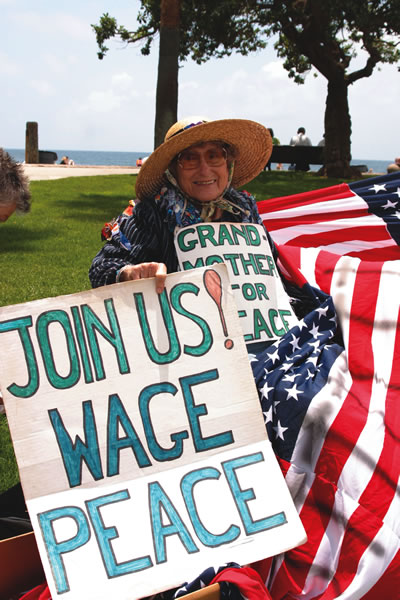Since Laguna Beach’s inception, residents have forged policies, protected place and stood up for their beliefs, by any means necessary.
By Sharael Kolberg and Linda Domingo
Laguna Beach residents aren’t afraid to fight for what they want. There is a long and rich history of activists—too many to name—who have held strong for what they believe in. From open space to sustainability, art to civil rights, these are passionate issues that some believe are worth standing up for, no matter how hard the battle.
This activist spirit may have been inspired by necessity, since Laguna was not created with a master plan like newer cities in Orange County. Residents had to lead the way and come together to build a town that would satisfy their wants and needs. As the county grew, Lagunans also had to fight to stop the growth from affecting the charm and uniqueness of Laguna Beach.
“Laguna had to have a lot of community activists because things were not in place,” says Ann Christoph, open space advocate and former mayor. “It was a blank slate. … This created a community spirit, and residents learned how to accomplish things. The city followed the activists instead of providing everything for everybody, like water lines, sewers and parks. … This is the way things have been done since the 1920s. The activist groups determined how things are today.”
Fighting for Open Space
One of most notable activist movements to take place in Laguna was the fight to keep Laguna Canyon from being developed. In 1989, nearly 8,000 people marched from downtown Laguna Beach to what is now the James Dilley Preserve, to protest a housing tract being developed in the canyon by the Irvine Company. James Dilley, founder of the Laguna Greenbelt, played a prominent role in fighting for open space between Laguna Beach and other cities.
Mark Chamberlain, one of the event’s organizers, says, “People marched to object and make their feelings felt about preserving the land and keeping it from being developed. They came together to keep the land just as it was, and just as it had been. It was kind of a mystical, magical thing.”
It was the largest environmental rally Orange County had ever seen—and it worked. Thanks to the determination to preserve our open space, we now enjoy the canyon and all of its beauty.
“The march to save Laguna Canyon showed me what a community could accomplish when it joined together to protect its open space treasures,” says Derek Ostensen, president of Laguna Canyon Foundation. “Years later, I learned that a large amount of Laguna Beach’s open space remained in private hands and [was] potentially susceptible to development. I began working with Scott Ferguson and Laguna Canyon Foundation to acquire the remaining open space for the public and restore it back to pristine condition. That was 10 years ago and at this point we’ve been able to preserve many open space properties on our ‘high-priority’ list. It has been a lot of hard work, but together—wow! So much has been achieved.”
Since its establishment in 1990, the Laguna Canyon Foundation, formed by environmental activists Mary Fegraus, Michael Pinto, Elisabeth Brown and Carolyn Wood, helped create the Laguna Coast Wilderness Park that is now part of a 22,000-acre regional open space. Mary, who was executive director of the foundation for 17 years, encourages others to get involved: “Activism takes many forms—not everyone is a leader—some can volunteer, others donate funds, others participate in a combination of ways.”
In 1994, there was another uprising, and Mark was once again involved. He spearheaded an effort to prevent a toll road from being constructed through Laguna Canyon. Mark was joined by other activists such as Jeanie Bernstein, a protestor for peace often found holding anti-war signs at Main Beach, who actually chained herself to a bulldozer. While the toll road was eventually built, the activists did cause significant delays in the project.
Educational Rights
In 1970, Cal State Fullerton student (currently a Laguna Beach resident) Tyrone Borelli served some jail time in an effort to protest the University of California regents’ imposition of tuition on the university’s students. This move, led by Governor Ronald Reagan, was in direct violation of the university’s long history of tuition-free public education.
“The tuition hikes made by the governor were so unpopular on every UC and state college campus that it became impossible for him to visit any campus with one exception: Cal State Fullerton,” Tyrone says.
According to Tyrone, when Gov. Reagan came to CSUF to give a campaign speech for his re-election, he came armed with Penal Code 415.5 that made it a crime to fight, or disturb another person “by loud and unreasonable noise” on the grounds of a state university. Reagan proved that he wasn’t afraid to use it when he had two students arrested for heckling him during his speech.
This act led to mayhem on campus, Tyrone says, “Several thousand students assembled in the quad, confronting a 90-member reinforced tact squad that began its advance into the quad clubbing students, videotaping students and eventually arresting 19 students.” Tyrone had a warrant out for his arrest for hitting a police officer in the helmet with an orange. He gave himself up and served 30 days in jail. “We didn’t want to take it to that extreme, but we were retaliating against Reagan trying to suppress student activism,” he explains.
In the end, the protests did not change the increase in tuition and many students suffered for what they believed in. Upon graduating with a teaching credential, Tyrone could not get a job because of his criminal record. That is, until Gov. Jerry Brown stepped in. In the late 1970s, he rescinded student activists’ criminal records and wiped their slate clean.
Since then, Tyrone has taken a somewhat more subdued stance with regard to events in Laguna Beach. He has opposed the annexing of south Laguna to the City of Laguna Beach, the building of the Montage, and has fought for the rights of the day laborers in Laguna Canyon.
“I will continue to protest what’s going on,” Tyrone says, “but now I do it through writing letters to the editor.”
Desegregating Laguna
Laguna Beach doesn’t immediately come to mind when listing key events in the civil rights movement of the 1950s and 1960s, but the town does have its own dark past, which certain activists fought to remedy. Arnold Hano arrived in Laguna in the 1950s, and was disturbed by the fact that the barbershops refused to serve black people. He, along with some local families, formed an organization called the Laguna Beach Interracial Citizens Committee. “We looked at the law and found a 1905 accommodation law in California that said they had to take anybody—that if they were going to open the door to the public, they had to take you no matter what color you were,” Arnold says. Armed with the law, the businesses continued to resist. “One day, we informed the press and the police, and we marched a black [man] and a white [man] into the six barbershops at the same time … and they caved in,” he says. “So that was that.” Since moving from New York to Laguna Beach, Arnold has been an active voice in the community. In 1971, he led the Yes on Aug. 3 Committee to restrict the citywide height limit to 36 feet, the first citywide height restriction to pass in the United States.
Arnold, who has spoken out about equal rights for women, African Americans, the homeless and illegal immigrants, believes in giving everyone a chance, but that is getting more difficult. “Usually an activist is facing opposition with money,” he says. “Today there is a lot of money in Laguna Beach.” Some of the tactics that Arnold employed successfully, such as writing letters, posting flyers and making statements at City Council meetings, still seem to be effective ways to make a difference.
The Future Activists
These days, activists seem to be fighting their battles online, for better or worse. Activists such as Laguna Beach’s Fred Karger, Rights Equal Rights president, has created a multimedia campaign called Boycott! Amway in response to Amway CEO Doug DeVos’s secret donation to a leading anti-lesbian, gay, bisexual and transgender organization called the National Organization for Marriage.
However, not everyone is certain that online campaigns are going to be more successful. “Social media and activism is something I’m not sure about,” local advocate Max Isles says. “I’m not sure how impactful it is to sign an online petition. Of course it can do some good … but, for too many people, signing an online petition is the sum total of their activism … whereas in the past they would have been out marching in the streets.”
While Ann thinks that the older generation is still leading the way, she feels that it’s not for lack of interest, but possible lack of time. “The economy has changed,” Ann says. “The wealth of the community has changed. Forty years ago, people had more free time and weren’t pressed to make high house payments. Younger people had more flexibility; now, they are really stretched financially and have to work more. … People are not as available to be as active.”
“A lot of us moved here because we wanted to be in a city that matched our core values … [of] sustainability and acceptance, but that has changed over the years and economics has become more important than the environment,” says resident Chris Prelitz, author of “Green Made Easy.” A founding member and president of Transition Laguna Beach, Chris works hard to keep the focus on what he feels is important. The group is dedicated to promoting self-reliance and sustainability at the community level and focuses on issues of local water, food, energy, mobility and environmental stewardship.
Whether or not the activist culture will continue to thrive in Laguna Beach remains to be seen, but with a merging of old ideals and new technology, there is hope that the city will retain the natural attributes that have attracted the kind of people that want to preserve them.
“I feel lucky to have grown up with citizens that are willing to protect and preserve our natural gifts,” Kelpfest organizer Michael Beanan says. “I feel a deep responsibility and wonderful opportunity to pass on what I have learned and support the good work of others.” LBM






